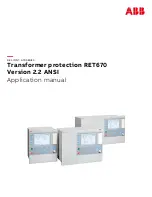
Second feature which is determined by the selected value for parameter
FilterLength
is the capability of the filter to separate the desired signal from the other disturbing
signals which may have similar frequency value. Note that the filter output will be the
phasor with the highest magnitude within certain “pass frequency band” around the
SetFrequency
defines the natural size of this pass frequency band for the
filter, depending on the selected value for parameter
FilterLength
.
Table 342:
Pass frequency band due to FilterLength
Value for parameter FilterLength For 50Hz power system
For 60Hz power system
0.1 s
±22.5 Hz
±27.0 Hz
0.2 s
±11.5 Hz
±14.0 Hz
0.5 s
±6.0 Hz
±7.2 Hz
1.0 s
±3.0 Hz
±3.6 Hz
2.0 s
±1.5 Hz
±1.8 Hz
4.0 s
±0.8 Hz
±1.0 Hz
Thus the longer length of the filter the better capability it has to reject the disturbing
signals close to the required frequency component and any other noise present in the
input signal waveform. For example if 46 Hz signal wants to be extracted in 50Hz
power system, then from
it can be concluded that “
FilterLength
=1,0 s” shall
be selected as a minimum value. However if frequency deviation of the fundamental
frequency signal in the power system are taken into account it may be advisable to
select “
FilterLength
=2,0 s” for such application.
Note that in case when no clear magnitude peak exist in the set pass frequency band
the filter will return zero values for the phasor magnitude and angle while the signal
frequency will have value minus one. Finally the set value for parameter
FilterLength
also defines the response time of the filter after a step change of the measured signal.
The filter will correctly estimate the new signal magnitude once 75% of the filter
length has been filed with the new signal value (i.e. after the change).
If for any reason this natural frequency band shall be extended (e.g. to get accurate but
wider filter) it is possible to increase the pass band by entering the value different from
zero for parameter
FreqBandWidth
. In such case the total filter pass band can be
defined as:
± (value given in
+ one-half of the set
FreqBandWidth
value)
Example if in 60Hz system the selected values are “
FilterLength
=1.0 s” and
“
FreqBandWidth
= 5.0” the total filter pass band will be ±(3.6+5.0/2)= ± 6.1 Hz.
It shall be noted that the phasor calculation is relatively computation demanding
(required certain amount of the CPU processing time). In order to control the CPU
usage for this filter, the setting parameter
OverLap
is used. This setting parameter
defines how often the new phasor value is calculated during time period defined by the
set value for the parameter
FilterLength
(see
). The following list gives
1MRK502052-UEN B
Section 12
System protection and control
599
Technical manual
Summary of Contents for Relion REG670
Page 1: ...Relion 670 series Generator protection REG670 2 0 IEC Technical manual ...
Page 2: ......
Page 44: ...38 ...
Page 58: ...52 ...
Page 80: ...74 ...
Page 106: ...100 ...
Page 482: ...476 ...
Page 548: ...542 ...
Page 570: ...564 ...
Page 600: ...594 ...
Page 608: ...602 ...
Page 630: ...624 ...
Page 862: ...856 ...
Page 1094: ...1088 ...
Page 1226: ...1220 ...
Page 1250: ...1244 ...
Page 1297: ...1291 ...











































